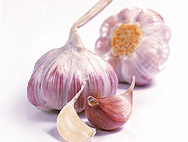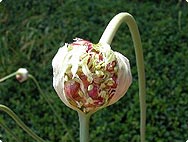A.Vogel search
When the internal search is activated, personal data such as your IP address is transmitted to our search engine Cludo. Data is thus transferred to a third country. Please click here if you want to display the internal search. You can find more information on data protection here: Privacy policy.
A.Vogel plant encyclopaedia
Allium sativum L.
Garlic
History

Garlic is an ancient cultivated plant which originates from the Central Asian Steppes. It was a valuable ancient Indian medicine. Both the garlic and the common onion (Allium cepa) found their way from the Far East to Egypt, where both plants were systematically cultivated by the Egyptians. This cultivation took away much of the plant's pungency and the Egyptians soon made garlic a regular article in their diet. The pyramid of Cheops would not have been built were it not for radish, onions and garlic; with the aid of these plants, the vast armies of people needed to build these structures were protected from exhaustion and infection. Priests, however, were not allowed to consume garlic, since the plant was considered holy, a gift of the gods and, last but not least, as an aphrodisiac.
The pungent clove spread westwards and northwards and was also used by the Greeks, Romans, Galls and Teutons as an ingredient in dishes, a seasoning and a herbal remedy. Garlic is described by Hippocrates and Dioscurides and is mentioned in herbal books from the Middle Ages. The northern saga of the gods, the Edda, describes garlic as a means of warding off evil spirits.
Garlic used to be applied in the treatment of conditions other than those it is normally used to treat today. Lonicerus wrote that garlic was the rustics' Theriac or Heal-All. He recommended its use in the treatment of "ulcers in the body" since it softens and opens the cyst and draws out the purulent discharge. Skin infections, inflammations, verminosis, kidney insufficiency, bronchial catarrh and stomach ache were the typical conditions to be treated by garlic. Pliny also advised that one should never sow the seeds of the plant but should instead cultivate it using the clove of the plant, otherwise the plant would become poisonous in the sixth year.
The ancient Greeks and Romans called garlic scorodon. The etymology of the name Allium is uncertain. The word has been associated with the Latin word, olere meaning "to smell" as well as the Greek term hallesthai, meaning "to jump out". This refers to the plant's rapid growth. The word Sativum bears some relation to the term "to sow". The word garlic is of Anglo-Saxon origin, being derived from gar, a "spear", and lac, "a plant" in reference to the shape of its leaves.
In spite of its pungent smell, garlic is a confirmed part of the diet of many different cultures. According to Dr. Vogel, this smell can be avoided by eating some fresh raw parsley at the same time as consuming garlic. It is, however, in our own interests to be somewhat more tolerant towards garlic's odour since the enormous breadth of its marvellous effects are well documented in innumerable publications, more particularly since the discovery of garlic's major component, allicin, in 1944.
Botanical characteristics

Garlic is a perennial plant which grows from a bulb. The elongated main bulb of the plant is situated at the base of the plant and sits on top of a hard, flat ring the underside of which is covered in roots. Around the main bulb are the closely-packed, curved bulblets or cloves. Each clove is enclosed by a white, membranous skin. Altogether they form the garlic onion, which is about as large as a fist.
The 30 to 80 cm high leafless flower stalk rises directly from the bulb. At its base this stalk is enclosed by tubular leafy sheaths; it usually bears five lineal, leek green-coloured leaves and at the tip of the stalk is the umbel, which is enclosed on one side by a very long, pointed white spathae. The reddish or greenish-white coloured blossoms are usually sterile and have more than six angular petals. In between the flowers are tiny, rotund, egg-shaped bulbils which form new plants when they drop to the ground. The plant flowers from July to August.
Habitat
Allium sativum is cultivated all over the world in a warm, moderate climate and is used largely as a herb and a vegetable.
Preparation
A.Vogel/Bioforce uses an oil macerate made from fresh garlic cloves and rapeseed oil; the two ingredients are formed into gelatine capsules.

